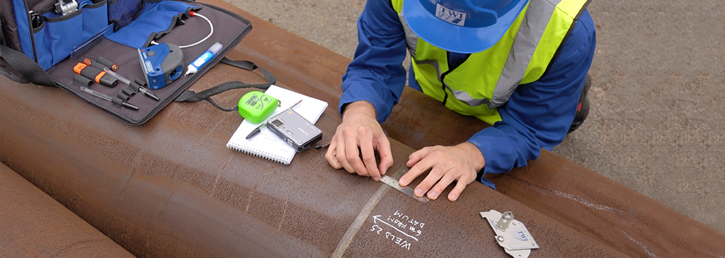Checking Out Advanced Tools and Approaches for Accurate Welding Evaluation
In the realm of welding inspection, the search of accuracy and dependability is paramount, stimulating the growth of innovative tools and techniques. Laser scanning advancements and computerized assessment systems, geared up with fabricated intelligence, are redefining the landscape by lowering human error and boosting security measures.
Ultrasonic Evaluating Developments
Ultrasonic testing technologies frequently represent the center of improvements in welding examination modern technologies. These technologies have actually significantly enhanced the capability to find and examine interruptions within bonded structures, ensuring boosted integrity and security.

Additionally, improvements in software formulas for data evaluation have actually enhanced the accuracy of flaw discovery and sizing. Automated ultrasonic testing systems now provide high-resolution imaging, making it possible for in-depth assessments of weld quality. These systems are commonly incorporated with sophisticated visualization devices, which assist in the interpretation of results.
Radiographic Examination Techniques
While ultrasonic screening innovations have set a high requirement in non-destructive examination, radiographic evaluation strategies proceed to play an integral function in welding assessment by supplying one-of-a-kind insights right into product honesty. Radiographic screening (RT) employs the use of X-rays or gamma rays to permeate materials, producing a radiograph that aesthetically stands for the inner framework of a weld. This imaging capability is vital for identifying subsurface defects such as porosity, inclusions, and splits that might not be noticeable with surface area assessments.
The procedure entails positioning a radiation resource on one side of the weld and a detector on the contrary side. Variants in material thickness and density affect the attenuation of the rays, producing a different picture that exactly delineates problems. RT is especially helpful for examining thick sections and intricate geometries where various other approaches might fall short.
Despite its effectiveness, radiographic inspection must be performed with rigorous adherence to safety methods as a result of the unsafe nature of ionizing radiation. The analysis of radiographs calls for proficient workers, as the quality of the analysis directly influences the dependability of the inspection. Subsequently, recurring improvements in digital radiography are improving picture clarity and analysis efficiency, strengthening RT's vital function in ensuring weld top quality.
Laser Scanning Advancements
Embracing laser scanning technology in welding inspection has reinvented the analysis of weld top quality and honesty. Unlike conventional evaluation methods, laser scanning offers quick information purchase, substantially improving the performance and precision of weld examinations.
Laser scanning developments have caused considerable renovations in characterizing and spotting surface area flaws such as porosity, lack of combination, and damages. The high-resolution data enables assessors to do detailed evaluations, ensuring that welds fulfill rigid sector criteria. Furthermore, this technique supports the advancement of electronic records, assisting in long-term quality control and traceability.
Furthermore, laser scanning modern technology integrates effortlessly with software application options created for automated issue detection and click here for more evaluation. The resultant data can be easily shared and assessed, promoting collaborative decision-making processes. As markets remain to require greater requirements for weld top quality, laser scanning continues to be at the forefront, supplying unmatched precision and performance in welding evaluation.
Automated Assessment Equipments

Automated evaluation systems provide the benefit of consistency, getting rid of human error and subjectivity from the evaluation process. They are created to operate in numerous atmospheres, from manufacturing floors to remote field websites, ensuring extensive coverage. Welding Inspection Madison. These systems can be programmed to stick to specific welding criteria and criteria, giving in-depth reports and documentation for quality assurance purposes
Additionally, the combination of cloud-based platforms assists in the storage and evaluation of vast quantities of examination information. This enables trend analysis and predictive maintenance, permitting producers to resolve possible concerns before they intensify. The fostering of automatic evaluation systems is a pivotal relocation in the direction of boosting the integrity and effectiveness of welding processes in commercial applications.
Enhancing Safety And Security and Efficiency
A substantial aspect of enhancing safety discover this and effectiveness in welding assessment depends on the integration of ingenious modern technologies that simplify procedures and minimize dangers. The fostering of sophisticated non-destructive testing (NDT) methods, such as ultrasonic testing, phased range ultrasonic screening (PAUT), and radiographic testing, plays a critical role in guaranteeing structural integrity without jeopardizing the safety of the workers included. These techniques permit thorough inspections with minimal downtime, decreasing possible dangers linked with typical techniques.
Moreover, the implementation of real-time information analytics and artificial intelligence algorithms has actually transformed the method examination information is analyzed. By using predictive analytics, prospective problems can be recognized before they materialize into important failures, making certain timely interventions and upkeep. This proactive technique significantly improves functional effectiveness and safety in welding procedures.
Additionally, remote inspection technologies, consisting of drones and robot crawlers furnished with high-resolution cams, allow inspectors to examine hard-to-reach areas without revealing them to dangerous conditions. This not just boosts examination precision but also decreases human threat. By leveraging these sophisticated devices and techniques, industries can attain higher security requirements and operational effectiveness, eventually leading to more trustworthy and lasting welding evaluation methods.
Final Thought
The integration of sophisticated tools and approaches in welding assessment dramatically boosts flaw detection and guarantees structural stability. These innovations not only increase examination performance yet also contribute to enhanced security and top quality guarantee in industrial welding applications.

Ultrasonic screening advancements regularly stand for the center of advancements in welding assessment technologies.While ultrasonic testing developments have actually established a high requirement in non-destructive exam, radiographic evaluation methods continue to play an important function in welding examination by providing special understandings right into product stability.Welcoming laser scanning innovation in this welding assessment has changed the assessment of weld high quality and stability. As markets proceed to demand higher standards for weld high quality, laser scanning remains at the forefront, providing unrivaled precision and effectiveness in welding assessment.
Automated examination systems provide the benefit of uniformity, getting rid of human error and subjectivity from the inspection process.